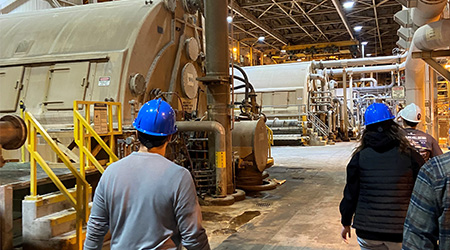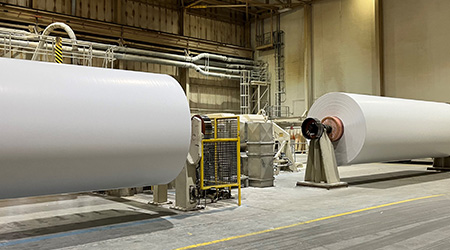Sustainable Direct Mail: Addressing Myths About Paper and Post

The United States has made significant strides in preserving its forests, with a net increase of 18,000,000 acres of forest area between 1990 and 2020. Despite this impressive achievement, many people remain unaware of the progress that’s been made. The paper and print industries are facing intense scrutiny, with concerns over deforestation and its impact on the environment. However, behind the scenes, they are prioritizing sustainable direct mail strategies and other green initiatives to make paper production more environmentally friendly.
As Earth Day approaches, it is time to debunk the myths surrounding the paper industry and highlight the steps that businesses can take to embrace eco-friendly practices. In this article, we will explore the truth behind paper and print, delve into sustainable direct mail practices, and share our experience visiting the Billerud Paper Mill, to help companies make informed decisions and maintain a sustainable presence in their daily operations.
Busting the Myths
With so much conflicting information, it is crucial to conduct thorough research and separate fact from fiction. Fortunately, organizations like Two Sides North America and Billerud are working tirelessly to promote sustainability in print, paper, and packaging. Before we jump into best practices for sustainable direct mail, let’s address the two common myths surrounding the environmental impact of print marketing.
Myth: Forests in the United States are shrinking.
Contrary to popular belief, forests in the U.S. are privately owned, renewable resources that have been expanding annually in recent decades. Modern forestry practices require managing the entire ecosystem — including trees, plants, wildlife, soil, and water — to ensure sustainable growth and preserve these precious natural resources for future generations. Protecting forests from wildfires, pests, and diseases are crucial steps of forest management efforts. These sustainable practices are evaluated and certified by independent bodies such as the Sustainable Forestry Initiative® and the Forest Stewardship Council®.
Landowners are also now financially incentivized to manage their forest assets, rather than developing them for non-forest purposes. This has led to a significant increase in the use of sustainable sources for paper production, making it one of the most recycled materials globally. In fact, 68% of paper stock and paper-based products were recovered for recycling in the United States in 2021. This practice not only extends the supply of valuable natural resources, but also saves landfill space and prevents greenhouse gas emissions, specifically methane, from being released into the atmosphere. These efforts are crucial in maintaining a sustainable presence in the paper industry and preserving the environment for future generations.
Myth: Mail is a wasteful and outdated form of communication.
Direct mail is a traditional form of print advertising that has been around for centuries, but many people are unaware of its advances in recent years. Direct mail is still one of the most targeted and personalized forms of communication available to businesses today. 56% of consumers across all generations have purchased goods or services because of the mail they received. This channel provides a tangible, nostalgic experience for consumers and is a welcomed break from the overwhelming number of digital advertisements.
Furthermore, advancements in printing technology and paper manufacturing have allowed the production of direct mail materials that use less paper and are more environmentally friendly than ever before. For instance, new printing techniques have made it possible to print variable data on a single sheet of paper, reducing the amount of paper needed. With advancements like this, sustainable direct mail has become a highly efficient form of communication that benefits both businesses and consumers.
Often considered more green, it’s important to note that digital marketing is not without its own environmental impacts. Digital devices require significant amounts of energy to manufacture, power, and dispose of after their useful life. The energy used to power digital marketing efforts can also contribute to greenhouse gas emissions. Moreover, there is a continual need to upgrade devices and infrastructure to keep up with the latest trends and technology, fostering a culture of disposability. As a result, devices are rapidly replaced, leading to a significant amount of e-waste that can be challenging to recycle and dispose of responsibly.
Both digital and physical approaches to marketing can be made more sustainable using environmentally friendly materials and practices.
Best Practices for Sustainable Direct Mail
Sustainable direct mail can be achieved by implementing a few changes — one of those being optimizing your mailing lists. By refining your lists to create personalized and targeted campaigns, you can reduce material waste and make your customers feel valued and understood. Working with your agency partner to review and update your mailing lists is crucial to achieving this. You’ll want to exclude anyone who is unlikely to respond to your offer, such as unqualified prospects or individuals who no longer reside at an old address. You’ll also want to practice a comprehensive merge-purge exercise to remove duplicates and preserve deliverability. Oftentimes you’ll get better results by sending fewer, targeted mailers than “spraying and praying.”
Once your mailing lists are refined, try simplifying your mail format. Postcards are an increasingly popular option for sectors such as e-commerce, food and beverage, and fitness. They are eco-friendly, cost-effective, and customizable. Alternatively, you can also create smaller mailers that use less paper, avoid plastic wrapping, and work with vendors that offer other sustainable mail options.
Many printers now use sustainable paper and inks for direct mail campaigns. This is an effective way for your brand to demonstrate its commitment to sustainability and appeal to consumers who are increasingly concerned about the environment. Recycled paper and FSC-certified products (from responsibly managed forests), combined with vegetable-based inks, help reduce environmental impact while reaching out to target audiences. Choose eco-friendly coatings, such as water-based or aqueous coatings, that have a lower environmental impact. You can even encourage your recipients to recycle or reuse the mail they receive by including the recycle symbol on your mailer. By implementing these changes, you can create sustainable direct mail campaigns that benefit both your business and the environment.
Our visit to the Billerud Paper Mill
Did you know that for every tree cut down in a Billerud-owned forest, three more are planted in its place?
In 2022, SeQuel Response had the pleasure of touring one of our key partners: the Billerud Quinnesec Paper Mill in the Upper Peninsula of Michigan. Our team was educated on the environmental impacts of paper production, as well as the green processes the print industry’s key players are implementing to reduce deforestation, energy consumption, and waste.
 |
 |
A forest’s life cycle is long and slow; trees are only felled when they are between 70 and 120 years old. Active forestry is critical to a more sustainable future and an efficient climate because it converts more carbon dioxide into natural renewable materials that contribute to a fossil-free world. When a tree is felled, the entire tree, from the trunk to the crown, is used. A third of the tree is used for construction materials, a third as raw material for paper and board, and the remainder as bioenergy.
After a tree is harvested, it must go through several steps before it can be transformed into a high-quality direct mail piece. In the Billerud mill, every stage of production is planned strategically to create the most efficient and sustainable process possible.
The tree’s bark is converted into biomass and used to power the mill. Integrated mills, such as Billerud, can be up to 95% energy self-sufficient, with any excess heat supplied to local communities to heat their homes. After the bark is removed, the wood is chipped and cooked, yielding pulp. After the pulp has been washed and screened, it is processed into paper in three stages: forming, pressing, and drying. The paper is then cut into reels, the width of which is determined by the press size specified by the paper vendors. Any paper that does not meet the quality standards is reprocessed or used for other renewable purposes. Finally, the paper is transformed into the direct mail pieces that will eventually make their way into mailboxes.
The green initiative work that is being done by paper producers like Billerud contributes to increased direct mail sustainability. We encourage others to learn more about the production process behind their paper products and consider the environmental impacts of their choices. Together, we can make a positive impact on the environment and ensure a brighter future for generations to come.

